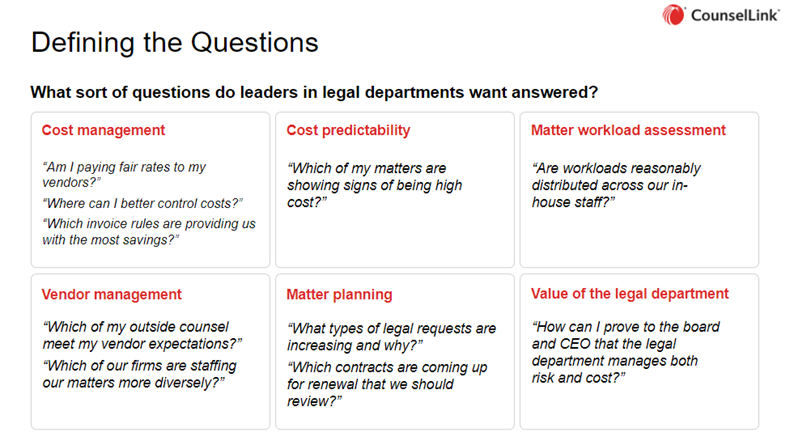
Data-driven Analytics to Improve Reporting
February 6, 2024
Proving value in the legal department comes with being proactive and demonstrating ways the department is efficient, saves money, minimizes exposure, and partners with business units. Then, the true value of the legal department can be showcased. To get there from here, however, proof of value requires data-driven analytics.
Acting on information provided by analytics also requires pinpointed knowledge about where additional cost savings can be realized; how budgets can be more successfully managed; whether risk is avoidable; and how process improvements occur.
Set Up a New Analysis with Questions
In the corporate legal department, daily decisions involve matter pricing, vendor selection, matter work, and payments. A new matter may be best priced under a fixed fee. What is the best practice approach to determine the best price for a matter? We start by considering questions to ask to set up the analysis of pricing a matter. Many of the starter questions can be adopted from a historical snapshot of previous patterns. Here are examples of questions to consider:
- What is the average budget for previous matters like this?
- How much variability has there been across similar matters?
- Among the law firms hired previously for these matters, what is the variability in matter pricing?
- Can patterns of variability be discerned and utilized in the analytical process?
- What are benchmark prices as a reference point?
- What are some benchmarks related to what the fee should be?
Three Categories of Questions to Reach Data-Informed Analytics
There’s a strong relationship between making decisions and the business questions that enable decision-making. Most people in legal departments begin by asking “what,” and this is where data accessibility begins to take shape.
To inform KPIs, basic sorts of data are often utilized in the way of polls. This type of data gathering provides simple methods of sharing metrics and results with leadership. With the polling results and information, for example, that are shared with management, the next type of questions that arise are the “what” questions. They often ask:
- What have we spent?
- What are we owed?
- What firm are we spending it with?
- Going a step further we ask why and what's next.
Then, the why questions follow:
- Why are we using the same, expensive law firm?
- Why is the budget not balanced?
- Why are more matters not resolved in a more timely manner?
Finally and expectedly, leadership asks the questions that pertain to a solution:
- What are we going to do about using expensive law firms?
- How can we adjust behavior to our advantage?
- What is required to bring more matters in-house?

When defining the questions you’d like answered, think of six overall buckets Questions that you may want to answer often fall into one of six buckets, but not exclusively. Of course, the Holy Grail of these six buckets is one demonstrating the value of the legal department, and this generally spans many of these categories.
To become a more mature legal department and improve value, the use of data analysis to inform decisions provides best practice. Through its analytics dashboard, CounselLink enables the methodology and process to help legal departments become analytically optimized.